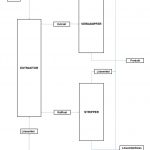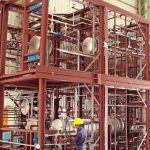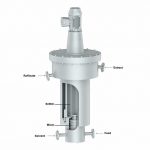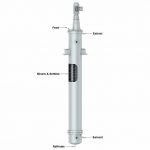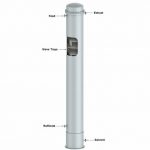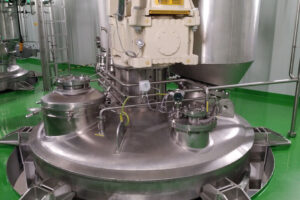Separation by extraction is based on the different affinities of components in two immiscible liquid phases. The feed containing a desired component is mixed intensively with an immiscible solvent. This solvent has a certain affinity to the desired component. Part of the component is therefore transferred to it from the feed. One flow at the outlet (the extract) is enriched with this component while another (the raffinate) is depleted of it.
The component and the solvent are separated using suitable evaporators. A small portion of the solvent from the raffinate stream is stripped out by another evaporator. The solvent is then recycled back to the extraction process.
From batch to continuous process
When extraction is carried out conventional batch kettles, fresh solvent for extraction is added several times to the same vessel. Each washing cycle incrementally extracts the desired product, producing dilute extract in each subsequent cycle. As a result, solvent use is high and the large volume of extract leads to higher recovery costs.
Changing from a batch to a continuous process can provide an attractive return on investment. As one example, an agrochemical was previously manufactured using an established batch extraction process where 10 tons of solvent were required to process 7 tons of aqueous mass. A total of five washes achieved 85 % recovery.
Equilibrium data generated in the laboratory indicated potential for improvement by switching over to continuous and counter-current extraction. Trials were subsequently conducted on the pilot ARDC (Asymmetric Rotating Disc Contactor) column.
A production scale extractor was designed and commissioned based on the trial results. The recovery rate increased from 85 to 93 % while solvent use was reduced from 10 to 7 tons. These improvements ensured a payback of less than 12 months.
ARDC and centrifugal extractor
The ARDC column has a stack of mixers and settlers arranged vertically inside a long vertical column. The heavy phase enters the column at the top and the light phase at the bottom. The desired component is transferred from one phase to another as these two phases flow counter-currently through the series of mixers and settlers. The continuous operation ensures consistent results. The column is easy to automate and saves space.
The large hold-up in the ARDC column tends to deter customers in the pharmaceutical industry. A centrifugal extractor with a very small hold-up and the ability to change over quickly from one batch to another addresses their concerns.
The two phases are mixed with a high intensity in the mixing chamber of the centrifugal extractor. The mixture then enters a rotating cylinder, where it experiences high centrifugal force and quickly separates into two phases. The accelerated mixing and separation result in a very small hold-up in the extractor.
The sieve tray column as extractor
If the feed and solvent have low surface tension values, the use of an ARDC column or a centrifugal extractor can result in a stable emulsion, making these options unviable. A classical sieve tray column is well suited for such cases. The sieve tray facilitates controlled formation of droplets in the dispersed phase with little shear. An optimised tray design ensures good mass transfer characteristics without leading to emulsion formation.
Piloting is a must
Prior to a new application, careful investigation in the laboratory will establish the phase equilibrium data which reveals the relationship between the number of extraction stages and the possible feed-to-solvent ratio. Further data on the densities and surface tension values gives an idea of the type of extractor which is best suited for this particular scenario.
However, it is not advisable to base decisions solely on laboratory data if unpleasant surprises are to be avoided. It is important to validate the design assumptions at the pilot scale level with scaled-down equipment geometries which are close to those of the production scale apparatus.
In view of the significance of this step, Technoforce has invested in pilot plant test facilities for all three types of extractor. Customers are encouraged to use these facilities extensively to generate confidence in the design concept. The pilot tests also provide essential data for the scale-up.
Technoforce generates added value to support the successful implementation of production scale projects. The sizing data for an evaporator and stripper downstream of the extraction step is likewise determined by the pilot facilities. After successful piloting, these two technologies can also be supplied as a modular system together with the extractor in a single skid-mounted package. This integrated system cuts down on the execution time and costs.
Online search: cpp0218technoforce
Hall 4.0, Booth G34





